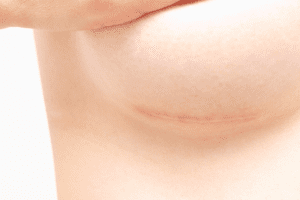8-15% of women who undergo breast augmentation or breast reconstruction procedures experience Capsular Contracture
You’ve decided to have breast augmentation surgery, congratulations! Being comfortable in our own skin is always the goal. Unfortunately, sometimes there are knots in the floss, and something can go sideways. Before having your procedure, it’s time for a reality check about the possibilities of complications with your specific surgery. Complications are real, so let’s get familiar with one of the most common – Capsular Contracture.
Below is an overview of what it is, the risks involved, why it occurs, and the options you have to fix it.
What Is A Capsular Contracture?
 A breast augmentation procedure involves inserting a foreign body into the breast, which is an implant. The implants form scar tissue or capsule around it due to the body’s natural healing process. The capsule protects the implants and helps them to stay in place. However, sometimes the capsule tends to over-grow abnormally, resulting in tightening and hardening to compress the breast implant, causing pain and distress over time. If you are experiencing something similar, it’s a good idea to talk to a surgeon and get yourself checked because it can be a capsular contracture.
A breast augmentation procedure involves inserting a foreign body into the breast, which is an implant. The implants form scar tissue or capsule around it due to the body’s natural healing process. The capsule protects the implants and helps them to stay in place. However, sometimes the capsule tends to over-grow abnormally, resulting in tightening and hardening to compress the breast implant, causing pain and distress over time. If you are experiencing something similar, it’s a good idea to talk to a surgeon and get yourself checked because it can be a capsular contracture.
According to the Archives of Plastic Surgery, the overall incidence of capsular contracture is around 10.6% percent, with about 75 percent of cases occurring within 2 years of breast augmentation surgery.
Why Does A Capsular Contracture Occur?
The exact cause of a capsular contracture formation is undecided because it’s typically unpredictable. Though, several risk factors may increase the chances of developing capsular contracture.
- Patient lifestyle, the procedure, and smoking raise the likelihood.
- Other factors may be linked to autoimmune disorders, radiation exposure, or some form of breast trauma.
- Circumstances can include conditions such as a mild infection contracted during surgery or blood vessel damage.
- Choosing a larger implant stretching the skin can increase the likelihood of developing capsular contracture.
How to Diagnose A Capsular Contracture?
When you notice your breast shape is different, along with pressure or tightening around the area followed by pain, are signs and symptoms of when you need to get a physical examination. Treating it sooner results in a better and safer outcome.
Dr. Barrett will assess the severity and degree of capsular contracture using distinct levels and is measured on a four-grade scale known as the Baker’s Classification. The grading is rated as:
Baker’s Grade I: the breast is soft and normal
Baker’s Grade II: the breast feels less soft than usual; the implant can be felt
Baker’s Grade III: the breast feels firm, and the implant can be felt easily, but an asymmetry of shape can be noticed
Baker’s Grade IV: the breast is hard, tender, and painful to touch, and the shape appears to be distorted prominently
Grades I and II usually go unnoticed and may not require treatment. In contrast, Grades III and IV are deemed severe and require intervention.
How to Reduce A Risk of Developing Capsular Contracture?
- First, the precise placement of an implant is critical and can significantly influence a capsular contracture risk. Placement of the implant under
 the muscle partially or totally (subpectoral or partially submuscular) can reduce the risk and enhance the overall appearance; however, placing it entirely under the muscle gives even more protection. However, placing an implant over a muscle can increase capsular contracture risk by about 12-18%, as stated by the American Society of Plastic Surgeons (ASPS).
the muscle partially or totally (subpectoral or partially submuscular) can reduce the risk and enhance the overall appearance; however, placing it entirely under the muscle gives even more protection. However, placing an implant over a muscle can increase capsular contracture risk by about 12-18%, as stated by the American Society of Plastic Surgeons (ASPS). - The incidence of capsular contracture is lower when using textured implants as compared to other types of implants.
- According to the ASPS, massaging might help reduce the risk; However, there are no adequate studies to prove this. Surgeons still recommend massaging since it can help the breasts soften post-operatively, reduce swelling, and help the patient recover.
- A method called a “no-touch” technique can highly reduce the risk of capsular contracture. In this approach, the implants are removed from their sterile packaging when they are ready to be inserted into the breast tissue. This ensures the implant is never exposed to contamination present in the air or on your skin, which could attach to the implant and inflame the surrounding tissue, resulting in infection and later developing capsular contracture. During your consultation, discuss the techniques used by Dr. Barrett to decrease the risk of capsular contracture.
What are the treatment options available for Capsular Contracture?
Capsular contracture repair surgery can be of two types: total and subtotal.
The total capsulectomy procedure involves the removal of your breast implant along with the entire capsule of scar tissue.
En bloc capsulectomy is a variation of a total capsulectomy where your breast implant and capsule are removed simultaneously. When you have a ruptured breast implant, this approach can be more beneficial.
Subtotal capsulectomy is when there is the removal of only a part of the capsule. The incision is smaller as compared to the total capsulectomy.
A capsulotomy is merely removing the capsule to release the scar’s formation. Which is much more likely to cause the issue to recur when you have a ruptured breast implant, and why surgeons usually recommend patients undergo capsulectomy. It is more effective in reduces recurrence.
Research on Non-Surgical Treatment of Capsular Contracture
According to research in the Archives of Plastic Surgery, Zafirlukast (Accolate) shows remarkable results in softening the scar tissue around the implants and improving the capsular contracture. Studies have shown patients who’ve been taking Accolate experienced significant softening of the breasts over 3-6 months. Soon we might see Accolate reduce the recurrence of capsular contracture before needing surgery.
Takeaways
Capsular contraction is a condition that can lead to the formation of scar tissue around your breasts, which overgrows, resulting in pain and distortion of your breast’s shape.
If you are experiencing any of the severe symptoms of capsular contracture, we hope you schedule a consultation soon. If the information provided answered your questions, please share it with your friends and family. Do you want to learn more about Barrett Plastic Surgery? Subscribe to our blog, and follow us on social media at Twitter, TikTok, Instagram, Realself, YouTube, Snapchat, Yelp, and Facebook for updates or call 310-598-2648.
Thank you for visiting!

